本文使用RNNs预测温度,数据集使用weather time series dataset,该数据集包含14中不同特征,如气温、气压、湿度等,数据的统计间隔为10分钟,共包含2009年至2016年共计约42w数据。
根据输入特征数、输出序列长度不同,本文使用三种实现:
- Simple LSTM Model: 单一特征(温度)预测未来单一时刻的温度;
- 多特征(温度、湿度和气压)预测未来单一时刻的温度
- 多特征(温度、湿度和气压)预测未来多个时刻的温度;
本文为Tensorflow官方指南学习笔记,自己整理的完整代码见github。
基本依赖包和全局变量
import tensorflow as tf
import matplotlib as mpl
import matplotlib.pyplot as plt
import numpy as np
import os
import pandas as pd
mpl.rcParams['figure.figsize'] = (8, 6)
mpl.rcParams['axes.grid'] = False
tf.random.set_seed(13)
TRAIN_SPLIT = 300000
BUFFER_SIZE = 10000
EVALUATION_INTERVAL = 200
EPOCHS = 20
BATCH_SIZE = 256
载入数据集
zip_path = tf.keras.utils.get_file(
origin='https://storage.googleapis.com/tensorflow/tf-keras-datasets/jena_climate_2009_2016.csv.zip',
fname='jena_climate_2009_2016.csv.zip',
extract=True)
csv_path, _ = os.path.splitext(zip_path)
df = pd.read_csv(csv_path)
df[['T (degC)', 'Date Time']].set_index('Date Time').plot(subplots=True)
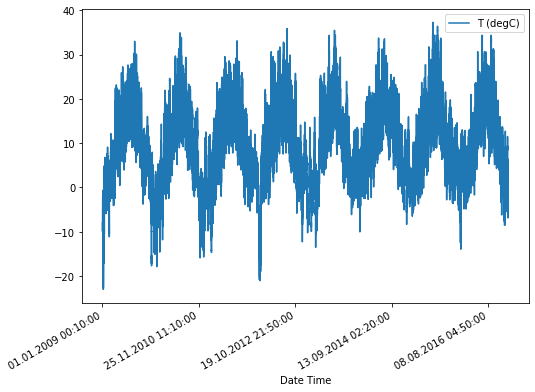
公共函数:数据集转为模型输入
def get_dataset(data, target, history_size, target_size, step=1, single=True, training=False):
"""获取数据集"""
n = data.shape[0]
range_size = history_size + target_size
x = [data[i:i + history_size:step] for i in range(n - range_size + 1)]
if single:
y = [data[i:i+1, target] for i in range(range_size - 1, n)]
else:
y = [data[i:i + target_size, target] for i in range(history_size, n - target_size + 1)]
x = np.array(x, dtype=np.float32)
y = np.array(y, dtype=np.float32)
dataset = tf.data.Dataset.from_tensor_slices((x, y))
if training:
dataset = dataset.cache().shuffle(BUFFER_SIZE).batch(BATCH_SIZE).repeat()
else:
dataset = dataset.batch(BATCH_SIZE).repeat()
return dataset
公共函数:打印过程曲线、预测值
def plot_data(history, future, predict, target_size, step, title, figure=False, show=False):
"""显示单条预测数据"""
if figure:
plt.figure()
history = np.array(history).flatten()
future = np.array(future).flatten()
predict = np.array(predict).flatten()
# single point
if future.shape[0] == 1:
delta = [0] if step == 1 else [target_size // step]
else:
delta = np.arange(future.shape[0]) / step
plt.plot(range(-history.shape[0], 0), history, '.-', label='History')
plt.plot(delta, future, 'rx', label='True Future')
plt.plot(delta, predict, 'go', alpha=0.5, label='Model Prediction')
plt.legend()
plt.xlim([-history.shape[0], (max(delta) + 5) * 2])
plt.xlabel('Time-Step')
if show:
plt.show()
def plot_history(history, title):
"""显示训练loss曲线"""
plt.figure()
epochs = range(len(history.history['loss']))
plt.semilogy(epochs, history.history['loss'], 'b', label='Training Loss')
plt.semilogy(epochs, history.history['val_loss'], 'r--', label='Validation Loss')
plt.title(title)
plt.xlabel('Epochs')
plt.ylabel('Log loss')
plt.legend()
plt.show()
模型一:Simple LSTM Model
# split dataset
dataset = df['T (degC)'].values.reshape(-1, 1)
train_dataset, valid_dataset = dataset[:TRAIN_SPLIT], dataset[TRAIN_SPLIT:]
# standard normalization
train_mean, train_std = train_dataset.mean(axis=0), train_dataset.std(axis=0)
dataset[:] = (dataset - train_mean) / train_std
# tf.data.Dataset input pipline
target, history_size, target_size, step = 0, 10, 1, 1
train_dataset = get_dataset(train_dataset, target, history_size, target_size, training=True)
valid_dataset = get_dataset(valid_dataset, target, history_size, target_size, training=False)
# Recurrent Neural Network
model = tf.keras.models.Sequential([
tf.keras.layers.LSTM(8, input_shape=(history_size, dataset.shape[1])),
tf.keras.layers.Dense(1)])
model.compile(optimizer='adam', loss='mse')
history = model.fit(
train_dataset,
epochs=EPOCHS,
steps_per_epoch=EVALUATION_INTERVAL,
validation_data=valid_dataset,
validation_steps=50)
# show history
plot_history(history, 'Simple Model Training and Validation Loss')
# show model prediction
# history, future, predict, target_size, step, title, figure=False, show=False
for i, (x, y) in enumerate(valid_dataset.take(3)):
plt.figure(figsize=(10, 5))
x, y, p = x[0, :, target], y[0], model.predict(x)[0]
plot_data(x, y, p, target_size, step, 'Simple LSTM model')


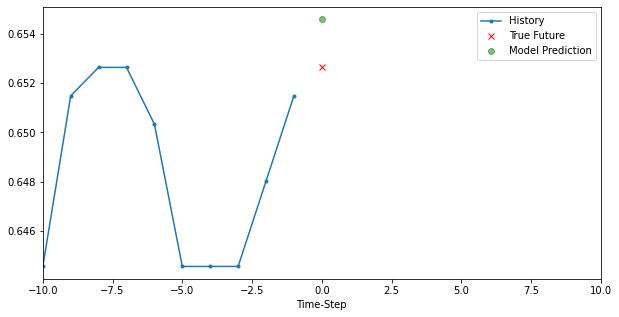
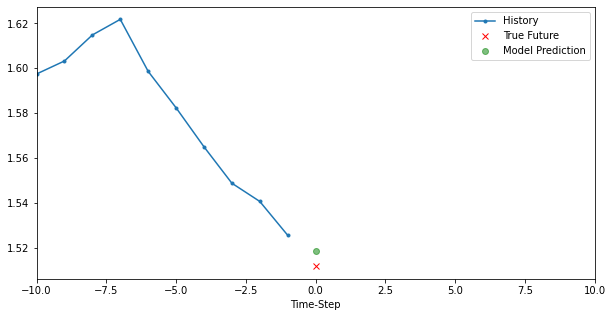
模型二:Single Variate Model
# split dataset
dataset = df[['p (mbar)', 'T (degC)', 'rho (g/m**3)']].values
train_dataset, valid_dataset = dataset[:TRAIN_SPLIT], dataset[TRAIN_SPLIT:]
# standard normalization
train_mean, train_std = train_dataset.mean(axis=0), train_dataset.std(axis=0)
dataset[:] = (dataset - train_mean) / train_std
# tf.data.Dataset input pipline
history_size, target, step, target_size = 720, 1, 6, 72
train_dataset = get_dataset(train_dataset, target, history_size, target_size, step, training=True)
valid_dataset = get_dataset(valid_dataset, target, history_size, target_size, step, training=False)
# creating the model in the TPUStrategy scope means we will train the model on the TPU
# with tpu_strategy.scope():
# Recurrent Neural Network
model = tf.keras.models.Sequential([
tf.keras.layers.LSTM(32),
tf.keras.layers.Dense(1)])
model.compile(optimizer='adam', loss=tf.keras.losses.Huber(delta=1.0))
history = model.fit(
train_dataset,
epochs= EPOCHS,
steps_per_epoch=EVALUATION_INTERVAL,
validation_data=valid_dataset,
validation_steps=50)
# show history
plot_history(history, 'Single-Variate Model Training and Validation Loss')
# show single data
for i, (x, y) in enumerate(valid_dataset.take(3)):
plt.figure(figsize=(10, 5))
x, y, p = x[0, :, target], y[0], model.predict(x)[0]
plot_data(x, y, p, target_size, step, 'Single-Variate LSTM model')
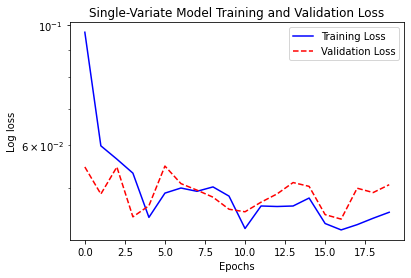
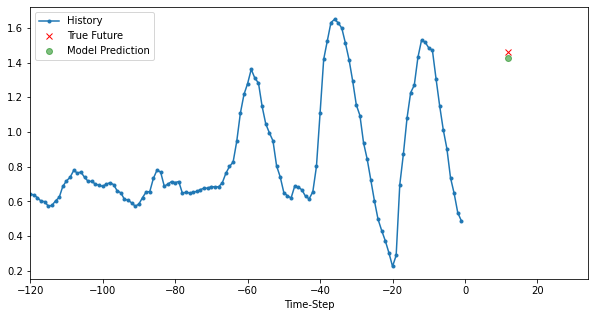
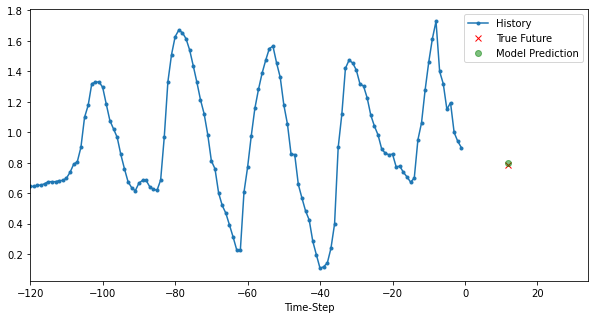

模型三:Multi Variate Model
# split dataset
dataset = df[['p (mbar)', 'T (degC)', 'rho (g/m**3)']].values
train_dataset, valid_dataset = dataset[:TRAIN_SPLIT], dataset[TRAIN_SPLIT:]
# standard normalization
train_mean, train_std = train_dataset.mean(axis=0), train_dataset.std(axis=0)
dataset[:] = (dataset - train_mean) / train_std
# tf.data.Dataset input pipline
history_size, target, step, target_size = 720, 1, 6, 72
train_dataset = get_dataset(train_dataset, target, history_size, target_size, step, single=False, training=True)
valid_dataset = get_dataset(valid_dataset, target, history_size, target_size, step, single=False, training=False)
# creating the model in the TPUStrategy scope means we will train the model on the TPU
# with tpu_strategy.scope():
# Recurrent Neural Network
model = tf.keras.models.Sequential([
tf.keras.layers.LSTM(64, return_sequences=True),
tf.keras.layers.LSTM(32, activation='tanh'),
tf.keras.layers.Flatten(),
tf.keras.layers.Dropout(0.1),
tf.keras.layers.Dense(200, activation='relu'),
tf.keras.layers.Dropout(0.1),
tf.keras.layers.Dense(target_size)])
model.compile(optimizer='adam', loss='mse')
history = model.fit(
train_dataset,
epochs= EPOCHS,
steps_per_epoch=EVALUATION_INTERVAL,
validation_data=valid_dataset,
validation_steps=50)
# show history
plot_history(history, 'Multi-Variate Model Training and Validation Loss')
# show single data
for i, (x, y) in enumerate(valid_dataset.take(3)):
plt.figure(figsize=(10, 5))
x, y, p = x[0, :, target], y[0], model.predict(x)[0]
plot_data(x, y, p, target_size, step, 'Multi-Variate LSTM model')

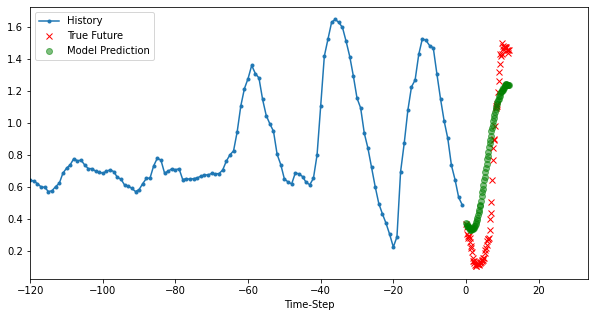
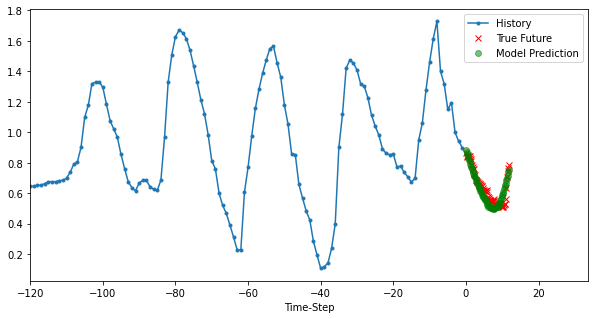

























 892
892

 被折叠的 条评论
为什么被折叠?
被折叠的 条评论
为什么被折叠?








